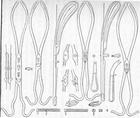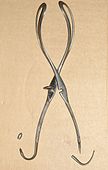Obstetric forceps
The obstetric forceps ( Latin forceps ) is an obstetric instrument used in childbirth complications to grasp and pull out the child via the vagina . The resulting termination of labor is called forceps delivery . It is based on the physical principle of the law of leverage , according to which the holding force acting on the ends of the forceps is smaller than the hand force applied by the fist. The development of forceps with two legs crossed in a joint brought significant progress. As a result of this, the hand force acting on the long thigh (fist closure) exerts a far greater force on the child's head than would be possible with simple forceps with a corresponding lever ratio through the jaws on the opposite side of the pivot point .
Instruments
Birth forceps consist of two identical metal parts (leaves). Each leaf consists of the spoon, which encompasses the child's head, the neck part on which the pliers lock is located, and the handle of the pliers, which is held securely by a pulling hook on the side when pulling.
indication
Reasons for a forceps delivery are infant hypoxia , exhaustion of the parturient or combined indications. Important prerequisites for carrying out the forceps delivery are that the head of the child has at least reached the middle of the pelvis and the exclusion of a disproportion between the mother's pelvis and the child's head. Alternatively, the suction cup can be used in this situation .
The advantage of the pliers over the suction cup is the ability to rotate the head.
technology
The child's head is grasped with the two spoons. The seat of the pliers is checked and a test pull is used to check whether the head follows the pull. The child's head develops in several contractions synchronized with the labor . The extraction can be supported by the Kristeller handle . The use of the forceps requires experience and skill on the part of the obstetrician .
Complications
In the child, the pressure of the spoon can cause abrasions and hematomas of the skin and periorbital tissue, as well as temporary or permanent paralysis of the facial nerve .
Possible maternal injuries are tears of the perineum, vagina and cervix (tears in the cervix). In addition, injuries to the levator ani muscle occur (which consists of several components that together form the pelvic floor, lifter of the anus: a muscle plate that closes the pelvis at the bottom), whereby tears of the muscle from the inside of the pubic bone are often described on both sides become. A Norwegian study, after questioning more than 3,000 women 15 to 23 years after the birth of their first child, came to the conclusion that the caesarean section was the gentlest. Vaginal births would put significantly more strain on the pelvic floor, but mostly instrumental deliveries with a suction cup and especially with forceps.
history
The development of the first obstetrical forceps in the 17th century is attributed to Peter Chamberlen (1560–1631), Peter the Elder , a Huguenot obstetrician, gynecologist and surgeon who emigrated from France to England , although the idea for these obstetrical forceps and similar instruments came from several early modern obstetricians was considered.
A similar instrument was developed by the Flemish surgeon and obstetrician Jan Palfijn (1650-1730). In 1723 he presented a prototype les mains de Palfyn to the Académie des Sciences in Paris . The Englishman William Smellie , an excellent obstetrician and good observer of the birthing mechanism, developed another recognized model. His small, uncurved pliers with joint lock, in which he further developed the model with curved pelvis by André Levret from France, found widespread use. The Scottish medical professor John Aitken († 1790) also contributed to the improvement of the obstetrical forceps as an inventor. At the beginning of the 19th century, Hermann Joseph Brünninghausen (1761–1834) developed the forceps with the so-called German lock.
Obstetrical forceps by William Smellie (1792)
First illustration by Andre Levret (1703–1780) pelvic curve (1747)
French forceps of the Levret- Jean-Louis Baudelocque type (1760–1860)
Étienne Stéphane Tarnier (1828–1897) pliers with tractor handle (1877) and the American Dewey model (1900)
Hugh Lenox Hodge (1796–1873) obstetric forceps developed from the Andre Levret type forceps USA (1833)
statistics
| year | Women giving birth |
of which by forceps delivery |
proportion of |
|---|---|---|---|
| 1994 | 757.693 | 17,453 | 2.3% |
| 1995 | 749.086 | 16,397 | 2.2% |
| 1996 | 778,900 | 16,634 | 2.2% |
| 1997 | 795.724 | 15,861 | 2.0% |
| 1998 | 766.508 | 14,525 | 1.9% |
| 1999 | 750.617 | 10,520 | 1.4% |
| 2000 | 746.625 | 12,139 | 1.6% |
| 2001 | 715.136 | 10,071 | 1.4% |
| 2002 | 698.410 | 9,366 | 1.3% |
| 2003 | 687.508 | 7,482 | 1.1% |
| 2004 | 682.767 | 7.142 | 1.1% |
| 2005 | 664,597 | 5,809 | 0.9% |
| 2006 | 652,642 | 5,148 | 0.8% |
| 2007 | 664.454 | 4,877 | 0.7% |
| 2008 | 662.783 | 4,528 | 0.7% |
| 2009 | 644.274 | 4,247 | 0.7% |
| 2010 | 656.390 | 3,797 | 0.6% |
| 2011 | 642.197 | 3,420 | 0.5% |
| 2012 | 653.215 | 3,037 | 0.5% |
| 2013 | 661.138 | 3,324 | 0.5% |
| 2014 | 692.794 | 3,026 | 0.4% |
| 2015 | 716,539 | 2,889 | 0.4% |
| 2016 | 761.777 | 2,670 | 0.4% |
| 2017 | 762.343 | 2,538 | 0.3% |
literature
- Schneider, Husslein: Obstetrics. Springer Verlag, ISBN 3-540-64762-7 .
- Zahedi, Nasser : History of the development of the forceps. Lehmanns (2003)
- Vilhelm Møller-Christensen: The history of the forceps. Medical dissertation Copenhagen 1938.
- Peter Schneck: obstetric forceps. In: Werner E. Gerabek , Bernhard D. Haage, Gundolf Keil , Wolfgang Wegner (eds.): Enzyklopädie Medizingeschichte. De Gruyter, Berlin / New York 2005, ISBN 3-11-015714-4 , p. 464 f.
- H. Bradtmöller: The history of obstetric forceps and levers. Göttingen 1935.
Web links
- Collection of obstetrical forceps of the University of Greifswald ( Memento from March 2, 2015 in the Internet Archive )
Individual evidence
- ↑ Pliers and other aids: Childbirth is not for rough craftsmen. FAZ from April 6, 2015.
- ↑ I. Volløyhaug, p Mørkved u. a .: Pelvic organ prolapse and incontinence 15-23years after first delivery: a cross-sectional study. In: BJOG: An International Journal of Obstetrics & Gynaecology. 2015, p. N / a, doi: 10.1111 / 1471-0528.13322 .
- ^ Peter M. Dunn: The Chamberlen family (1560-1728) and obstetric forceps. ( Memento of the original from September 6, 2014 in the Internet Archive ) Info: The archive link was inserted automatically and has not yet been checked. Please check the original and archive link according to the instructions and then remove this notice. Arch Dis Child Fetal Neonatal Ed 1999; 81: F232-F235.
- ↑ Werner E. Gerabek : Chamberlen. In: Werner E. Gerabek, Bernhard D. Haage, Gundolf Keil , Wolfgang Wegner (eds.): Enzyklopädie Medizingeschichte. De Gruyter, Berlin / New York 2005, ISBN 3-11-015714-4 , p. 237.
- ^ Hibbard, Bryan: Milestones in the evolution of obstetric forceps. P. 43 (PDF; 523 kB).
- ↑ Werner E. Gerabek : Aitken, John. In: Werner E. Gerabek, Bernhard D. Haage, Gundolf Keil , Wolfgang Wegner (eds.): Enzyklopädie Medizingeschichte. De Gruyter, Berlin / New York 2005, ISBN 3-11-015714-4 , p. 22.
- ^ HJ Brünninghausen about a new obstetric forceps invented by him, Stahel, Würzburg 1802.
- ^ Federal health reports: deliveries in hospitals (number and in percent). Structural characteristics: years, region, type of delivery. Retrieved January 8, 2020 .










